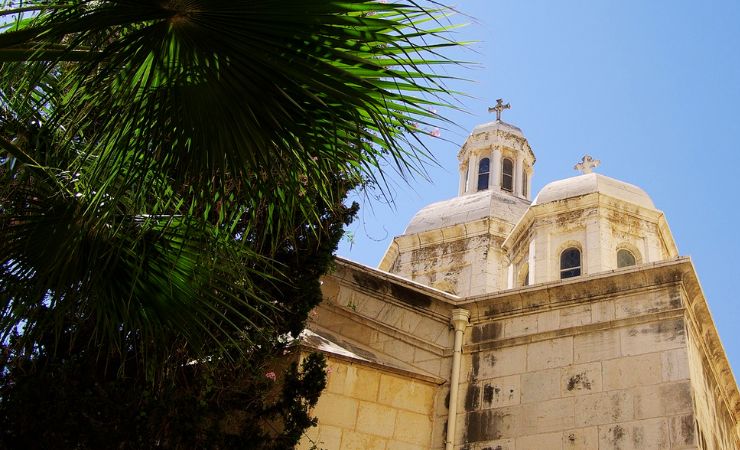The Church of the Condemnation and Imposition of the Cross
The Church of the Condemnation and Imposition of the Cross is a Roman Catholic church nestled within the Franciscan monastery in the old city of Jerusalem. This monastery also houses the Church of the Flagellation. Both churches are significant landmarks on the Via Dolorosa, with the Church of the Condemnation marking the traditional Second Station of the Cross.

Location
The Church of the Condemnation and Imposition of the Cross is on the path of the Via Dolorosa not far away from the Lion’s Gate, one of the Eastern gates of the Old City of Jerusalem.
Biblical context
The Church of the Condemnation and Imposition of the Cross commemorates two significant events from the New Testament:
Condemnation
After Jesus’ trial before Pontius Pilate, he was condemned to death by crucifixion. This momentous decision is recorded in the Gospel of John: “Then Pilate handed him over to them to be crucified.” (John 19:16)
Imposition of the Cross
Following the condemnation, Jesus was forced to bear the weight of the cross upon which he would be crucified. This poignant moment is depicted in the Gospel of Matthew:



Historical context
The church stands as a symbol of the place where, according to tradition, Jesus took up his cross after being sentenced to death by crucifixion. This belief is rooted in the discovery of Roman flagstones beneath the church and the adjacent Convent of the Sisters of Zion. These stones were initially thought to be part of Gabbatha, the pavement mentioned in the Bible as the location of Pontius Pilate’s judgment of Jesus. However, recent archaeological findings suggest that these slabs were actually part of the paving of one of two second-century forums constructed by Hadrian as part of the Aelia Capitolina.
Historically, the original church was erected during the Byzantine era. It underwent a transformation into a mosque before being restored to its Catholic roots in 1904.
Architectural highlights
The church boasts a distinctive design crowned by five white domes. Each dome rests on a drum adorned with stained-glass windows that depict themes from Christ’s Passion. Inside the church, visitors are greeted by papier-mâché figures in the apse that visually narrate stories of the Passion. One such depiction shows Pontius Pilate condemning Jesus to crucifixion, while another portrays John trying to shield the Virgin Mary from the sight of Jesus bearing the cross down the Via Dolorosa.
The walls of the church are adorned with illustrations, including one of Pontius Pilate washing his hands and another of soldiers imposing the cross on Jesus. The church’s ceiling is upheld by four pink marble pillars. Additionally, pilasters are present on many of the walls, and miniature Corinthian columns appear to support the altar.
A particularly intriguing feature of this church is the Roman period floor located next to its western wall. This floor, typical of that era, is crafted from large, striated stones designed to prevent animals’ hooves from slipping. The highlights of the church include:
-
Ancient Pavement: Excavations have revealed an ancient pavement near the church, believed to be part of the Roman Antonia Fortress. This could be where Jesus stood during his trial before Pilate.
-
Byzantine Mosaics: Beneath the current structure, remnants of Byzantine mosaics have been discovered, suggesting the existence of an earlier church or religious building on the site.
-
Crusader-era Relics: Various artifacts from the Crusader period have been unearthed, indicating the church’s significance during medieval times.
-
Inscriptions: Stone inscriptions in various languages have been found, bearing witness to the international appeal of this sacred site over the centuries.
Nearby Sites
- The Church of the Holy Sepulchre: Located further along the Via Dolorosa, this church is believed to be the site of Jesus’ crucifixion, burial, and resurrection.
-
The Pools of Bethesda: An ancient reservoir mentioned in the Gospel of John, where Jesus healed a paralyzed man. (John 5:1-15).
-
St. Anna’s Church: A beautiful 12th-century Crusader church known for its remarkable acoustics and serene atmosphere.
-
The Roman Cardo Maximus: Once the main street in ancient Roman cities, Jerusalem’s Cardo is a significant archaeological site that offers a glimpse into the city’s rich history.
- Church of the Flagellation: Another significant station on the Via Dolorosa, this church marks the spot where Jesus was said to have been scourged.



